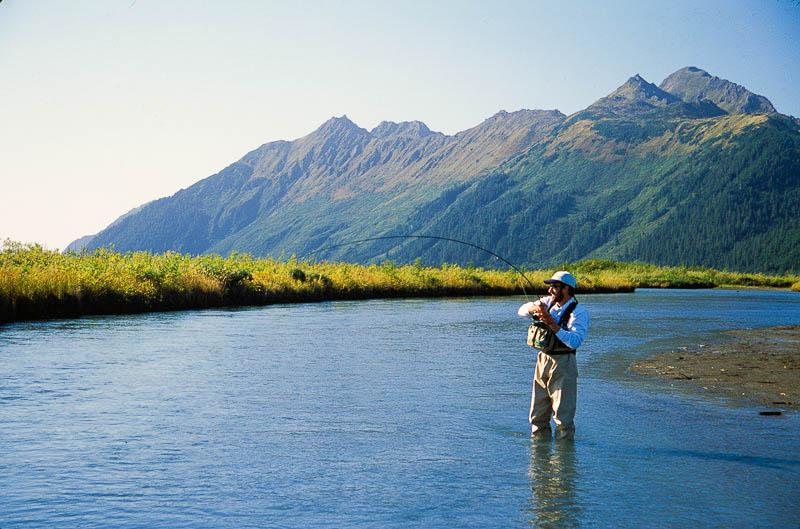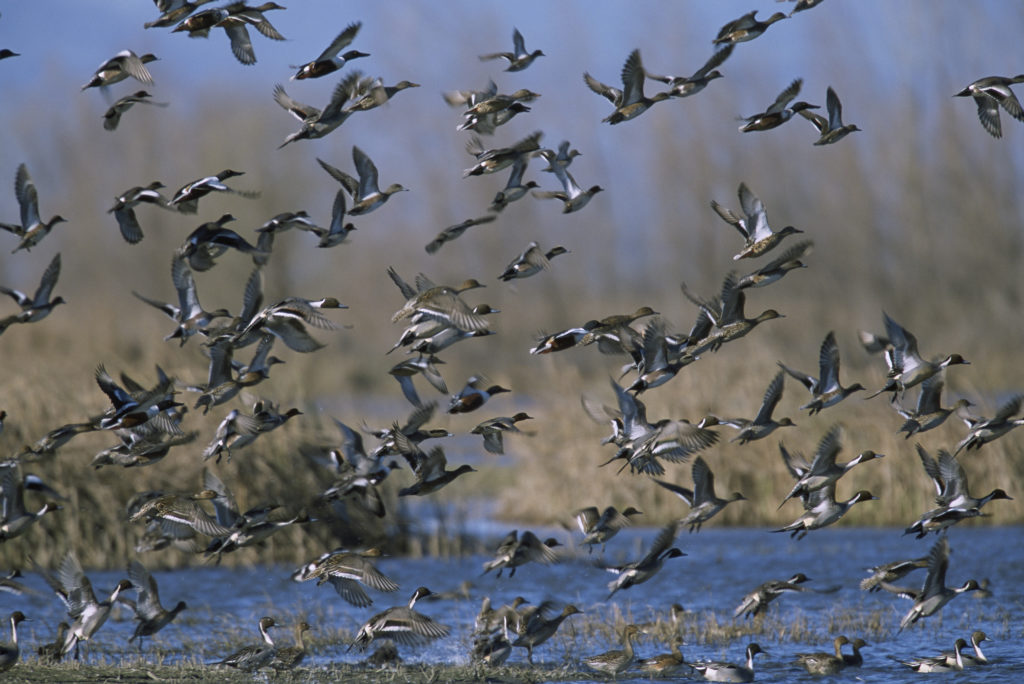Last updated on February 13th, 2024

From extreme droughts, flooding, and fires to altered migration patterns and “hoot owl” fishing restrictions, America’s sportsmen and women have seen firsthand the impacts of a changing climate. If we are to protect and restore the habitats that support all the species we love to pursue, the hunting and fishing community must be part of climate change solutions.
There is no one silver bullet or single set of actions that will turn the tides entirely—climate change can only be addressed with a comprehensive strategy that involves all of us and all the tools we have. Thankfully, this includes habitat conservation measures already supported by sportsmen and women.
Here are six habitat improvement strategies that provide this win-win proposition: better hunting and fishing opportunities and fewer climate-change-driven impacts to fish and wildlife.
Improve Forest Management
The nation’s forests provide habitat for wildlife, shade to cool trout streams, and many convenient places to hang a tree stand, but they also store carbon—keeping carbon dioxide from entering the atmosphere and warming the globe. In fact, across the world, forests store as much as one-third of all emissions from burning fossil fuels or about 2.6 billion tons of carbon each year.
Forests also draw additional carbon out of the atmosphere. Young, healthy growing forests mostly sequester carbon while older forests store it, which is why it helps to have diverse, well-managed forests. Unfortunately, decades of fire suppression and past management practices have left many public forests in poor health and vulnerable to uncharacteristically large wildfires. Poorly managed forests can alter the carbon storage and sequestration balance.
Hunters and anglers are already advocating for reforestation, active management of young stands, and conservation of late-successional forests, because these measures promote diverse habitat conditions, reduce fire risk, and filter polluted runoff that would otherwise harm trout and salmon streams. But these are also natural climate solutions. One of the Theodore Roosevelt Conservation Partnership’s s top priorities this year is pushing decision-makers to ensure that savings from the recent wildfire funding fix will go toward forest health and management. This is just one step toward securing more of the habitat and climate benefits of our national forests.
Reverse Grasslands Loss
Native grasslands are being lost at an alarming rate due to agricultural conversion, development, and other factors. Just like forests, degraded western rangelands and grasslands are less resilient to temperature and weather changes, and their carbon storage and sequestering benefits are altered as more habitat damage is done. Invasive species like cheatgrass now dominate many sagebrush landscapes and have dramatically altered this ecosystem’s productivity, stability, and fire regime.
But grasslands and shrub communities also absorb huge amounts of carbon.
Restoration and conservation of rangelands and grasslands will be an important component of a broad-scale, comprehensive habitat and climate resilience strategy. We need to stop converting these habitats and focus on restoring grasslands to increase their resilience and productivity.
Conserve and Restore Wetlands

Inland and coastal wetlands, marshes, estuaries, swamps, deltas, and floodplains are among nature’s most productive ecosystems—providing vital habitat for migratory waterfowl and both fresh and saltwater species of gamefish—that also store carbon.
Wetlands across the country already provide critical habitat, reduce erosion, improve water quality, and filter flood waters to protect our communities. But they are also being lost—drained, developed, converted to crops, or damaged beyond repair.
We are still fighting the rollback of Clean Water Act protections that has stripped wetlands and headwater streams of the safeguards that could prevent further wetlands loss.
Globally, wetlands may presently sequester as much as 700 billion tons of carbon each year. Once drained or partially dried, these areas may become a net source of methane and carbon dioxide entering the atmosphere. They are also particularly vulnerable to climate change. Rising temperatures and increased drought can convert permanent wetlands to semi-permanent or seasonal ones.
We need to protect our remaining wetlands and reverse the loss while restoring those that have been altered to help meet the nation’s goals for flood control, clean water, habitat, and carbon reduction.
Boost Farm Bill Conservation Programs
Roughly 40 percent of the United States is in agricultural production. This sector represents about 9 percent of all carbon emissions, but farmers and ranchers also contribute significantly to carbon storage and sequestration when they manage and preserve grasslands, wetlands, and forests.
Our community is already preparing to work with Congress on a 2023 Farm Bill with strong conservation funding, and this would give landowners more of a chance to contribute to climate change solutions, as well. Increasing Conservation Reserve Program acreage to 50 million acres, for example, would enhance the habitat benefits for whitetail and mule deer, prairie chickens, pheasants, quail, wild turkeys, waterfowl, and countless other species—not to mention provide better hunting and fishing experiences for the sportsmen and women who rely on CRP lands for access.
Boosting the CRP would also give landowners the option to conserve grasslands and wetlands that combat climate change. Expanding this and other conservation programs would be a great starting point for strengthening the role that private landowners play in the climate fight.
Continue the Gulf Coast Comeback

Rising seas have already destroyed thousands of miles of coastline and hundreds of thousands of acres of coastal salt marshes and seagrass beds that are vital to many sportfish and waterfowl. Louisiana’s more seasoned duck hunters can likely point to actual ground they once hunted that has now been lost.
The good news is that building coastal infrastructure is a viable solution to fight these catastrophic losses.
Reparation funds from the BP oil spill have already helped to rebuild habitat health beyond what was damaged in the environmental disaster and recover some of what has been lost to subsidence, erosion, and sea-level rise.
The continued conservation and restoration of these habitats can help save lives and protect coastal communities, while providing healthier fisheries, cleaner water, and enhancing resilience to climate change. We need to ensure federal programs and funding are available to identify areas for protection, restoration, or management and to develop effective strategies to sustain the natural benefits of coastal habitats.
Shore Up Streambanks
One of the most obvious impacts of climate change for America’s anglers is rising water temperatures that threaten coldwater trout species. This is compounded in places where streams have been degraded by major floods, wildfires, dam construction and land-use changes. Many conservation volunteers cut their teeth on projects aimed at restoring healthy stream flows, reducing streambank erosion, and ultimately lowering water temperatures, but they may not realize riparian areas have an underappreciated ability to store carbon, both in vegetation and the soil itself.
At the federal level, we will need to invest in numerous solutions to build resilient river systems and ensure our lakes, rivers, and streams are able to function as productive carbon sinks while also supporting the fish and wildlife we love to pursue. Programs and policies emphasizing water conservation, water efficiency, nutrient reductions, and riparian zone protection and restoration will be critical.
Let Habitat Work
Any national climate strategy must include land- and water-based solutions that harness the power of our natural systems. But, as you can see, these habitat improvements are already on our wish list as a conservation community.
It’s important to note that these actions will not only benefit fish and wildlife, enhance soil quality, and create cleaner water—they will also create jobs and strengthen rural economies. But there is no time to waste, whether we’re talking about implementing natural climate solutions, reversing habitat loss and wildlife species declines, or putting Americans back to work through conservation. We have to stop debating about resolving climate change and get to work on implementing these straightforward natural solutions. Let’s allow habitat to contribute all it can to the climate fight.
Ed Arnett is the Chief Scientist at Theodore Roosevelt Conservation Partnership.
